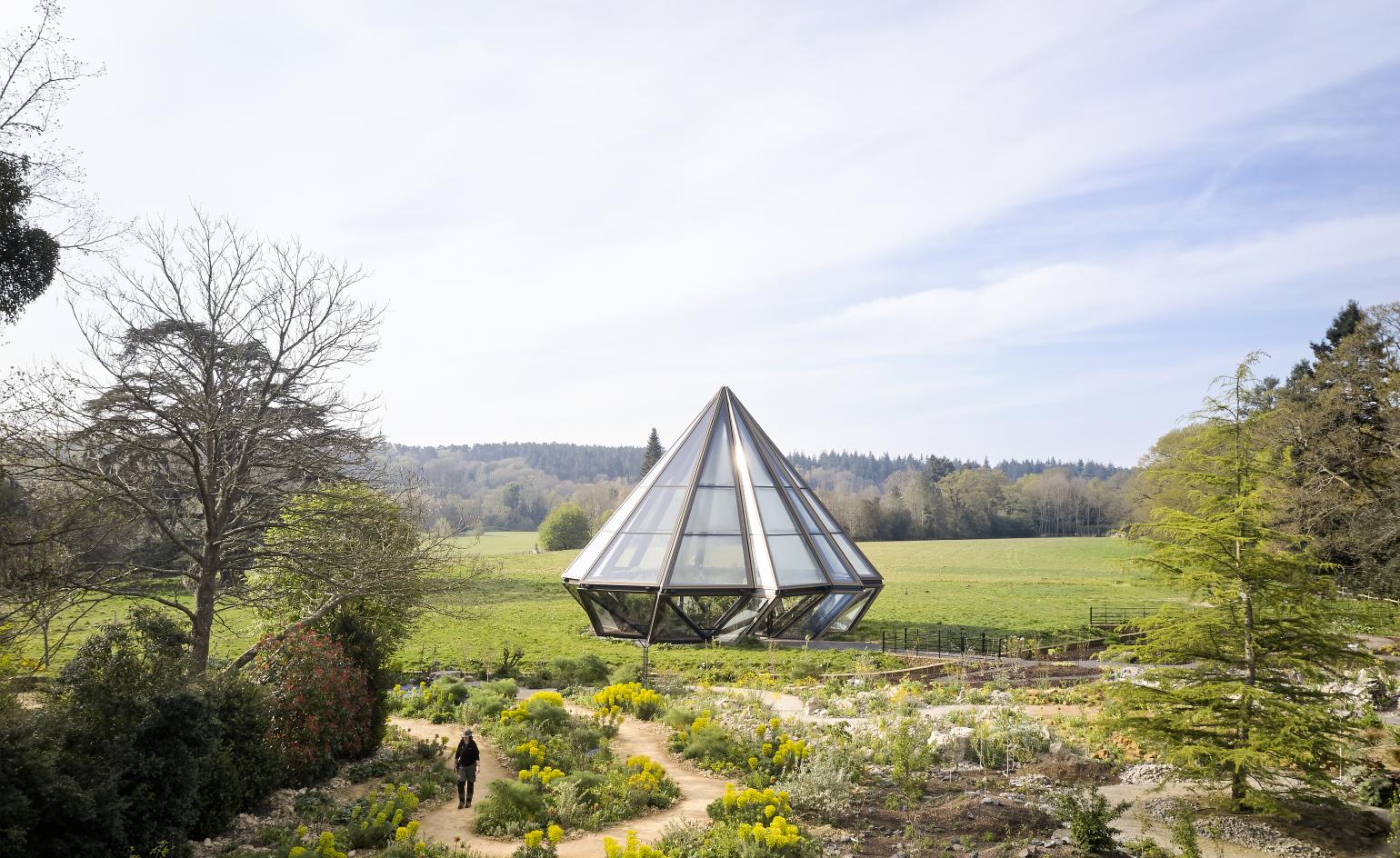Heatherwick Studio’s glasshouse architecture flowers in the English countryside
Heatherwick Studio’s new glasshouse is a floral haven in West Sussex's Woolbeding Gardens
Hufton + Crow - Photography

Before creating large-scale, headline-making landmarks – the Vessel and Little Island in New York, and 1000 Trees in Shanghai amongst them – Thomas Heatherwick established his name with striking, small-scale works, building-sized objects, witty, ingenious and often kinetic. There was 2004’s curling, crowd-pleasing Rolling Bridge in London’s Paddington and The Sitooterie, a hedgehoggy garden seat, created two years earlier in Essex. A new piece of glasshouse architecture at Woolbeding Gardens in West Sussex traces a line back to these early works in its one-good-idea elegance and a kind of Victorian enchantment with the mechanics and engineering of movement. A 15m-tall, ten-sided blossoming jewel, the Woolbeding Glasshouse is the centrepiece of a new garden that, horticulturally, takes the visitor on a winding trip along the Silk Route, from Turkey to China, and, functionally, protects a cluster of subtropical plants. In effect, it does much more than that, coming off like a carefully parked spacecraft for higher-intelligence plant-life pilots.
Woolbeding Glasshouse by Heatherwick Studio

This piece of glasshouse architecture was commissioned by Stewart Grimshaw, partner of the late Simon Sainsbury, who together leased the 1,000-acre Woolbeding estate from the National Trust in the early 1970s. The pair added a number of gardens and contemporary follies to the estate over the years. After a chance meeting with Heatherwick, Grimshaw set on creating something even more remarkable, a lasting legacy of their time in charge of the estate. There had been a large Victorian glasshouse at Woolbeding but it was long gone and Grimshaw mooted the idea of creating a new one, radical in scale and ambition. Heatherwick was, of course, intrigued and signed up for the challenge.
Heatherwick says he spent research time reading about Joseph Paxton, 19th-century gardener, engineer and designer of the Crystal Palace and the Great Conservatory at Chatsworth House in Oxfordshire. He also thought back to his student days in Manchester. ‘I lived near Fletcher Moss Botanical Gardens and they had a glass orchid house. And I knew the glasshouse at Woolbeding had to have that kind of focus.’

Grimshaw had studied botany and came up with the idea of the Silk Route Garden. Two years in the devising and planting, the garden path now winds through 12 biomes, from Mediterranean Bursa through Anatolian Plateau and Tibetan Meadows and over a sheep-repelling ha-ha to the subtropical glasshouse, creating a kind of teasing theatre along the way. ‘The garden is a kind of maze where you keep thinking you are near the end and at the glasshouse but it keeps pulling you back,’ Heatherwick says.
Functionally, the glasshouse has to shield umbrella trees, magnolias and bananas against harsh winter winds and rain but be open to the elements when they are calmer and kinder. That demand presented the engineering and aesthetic challenge Heatherwick needed. He wanted to do more than create a frame for open-and-close windows but, rather, to create a structure that fully bloomed on demand, offering its occupants clear blue skies. A series of hydraulic rams lower the triangular petals or sepals in an elegant and all-but-silent four-minute dance. At full stretch, they sit at the same angle as the glass sides of the base, creating a kind of glass crown.
Heatherwick says the technical challenge was ensuring the building could handle that shifting centre of gravity and that the sepals achieved a weather-proof seal when closed and didn’t get in any kind of tangle in the blossoming process. The final design was realised with the help of specialist engineers Bellapart.

Leaf-skeleton engravings on ground-level grills and a metal door handle shaped after an actual bamboo add to the glasshouse’s steampunk air. And it makes sense that the building has a retro sci-fi thrust to it. ‘The Victorian glasshouses were these really gorgeous structures and in some way the forerunner of modern buildings and high-tech architecture in the way they used glass and metal.’
Receive our daily digest of inspiration, escapism and design stories from around the world direct to your inbox.
For Heatherwick, though, the Woolbeding Glasshouse, funded by The Woolbeding Charity and the National Trust, is a permanent tribute to a particular architectural legacy and an attempt to create something like it. ‘The Georgians and Victorians were such prolific builders and those buildings, in their adaptability, flexibility and their cherish-worthiness, have proved to be arguably the most sustainable buildings in history,’ Heatherwick proposes.
‘Now the average life of a commercial building is 40 years, which is environmentally terrible. But the real terror is that we end up just protecting history and not making new history. I hope that we don’t lose our confidence to make new things that might have some of the qualities and values of the things that we cherish from the past.’


INFORMATION
The Woolbeding Glasshouse and the Silk Route Garden are open on Thursdays and Fridays from 28 April to 30 September
-
 The new Tudor Ranger watches master perfectly executed simplicity
The new Tudor Ranger watches master perfectly executed simplicityThe Tudor Ranger watches look back to the 1960s for a clean and legible design
-
 This late-night hangout brings back 1970s glam to LA’s Sunset Boulevard
This late-night hangout brings back 1970s glam to LA’s Sunset BoulevardGalerie On Sunset is primed for strong drinks, shared plates, live music, and long nights
-
 How Memphis developed from an informal gathering of restless creatives into one of design's most influential movements
How Memphis developed from an informal gathering of restless creatives into one of design's most influential movementsEverything you want to know about Memphis Design, from its history to its leading figures to the pieces to know (and buy)
-
 Step inside this perfectly pitched stone cottage in the Scottish Highlands
Step inside this perfectly pitched stone cottage in the Scottish HighlandsA stone cottage transformed by award-winning Glasgow-based practice Loader Monteith reimagines an old dwelling near Inverness into a cosy contemporary home
-
 This curved brick home by Flawk blends quiet sophistication and playful details
This curved brick home by Flawk blends quiet sophistication and playful detailsDistilling developer Flawk’s belief that architecture can be joyful, precise and human, Runda brings a curving, sculptural form to a quiet corner of north London
-
 A compact Scottish home is a 'sunny place,' nestled into its thriving orchard setting
A compact Scottish home is a 'sunny place,' nestled into its thriving orchard settingGrianan (Gaelic for 'sunny place') is a single-storey Scottish home by Cameron Webster Architects set in rural Stirlingshire
-
 Porthmadog House mines the rich seam of Wales’ industrial past at the Dwyryd estuary
Porthmadog House mines the rich seam of Wales’ industrial past at the Dwyryd estuaryStröm Architects’ Porthmadog House, a slate and Corten steel seaside retreat in north Wales, reinterprets the area’s mining and ironworking heritage
-
 Arbour House is a north London home that lies low but punches high
Arbour House is a north London home that lies low but punches highArbour House by Andrei Saltykov is a low-lying Crouch End home with a striking roof structure that sets it apart
-
 A former agricultural building is transformed into a minimal rural home by Bindloss Dawes
A former agricultural building is transformed into a minimal rural home by Bindloss DawesZero-carbon design meets adaptive re-use in the Tractor Shed, a stripped-back house in a country village by Somerset architects Bindloss Dawes
-
 RIBA House of the Year 2025 is a ‘rare mixture of sensitivity and boldness’
RIBA House of the Year 2025 is a ‘rare mixture of sensitivity and boldness’Topping the list of seven shortlisted homes, Izat Arundell’s Hebridean self-build – named Caochan na Creige – is announced as the RIBA House of the Year 2025
-
 In addition to brutalist buildings, Alison Smithson designed some of the most creative Christmas cards we've seen
In addition to brutalist buildings, Alison Smithson designed some of the most creative Christmas cards we've seenThe architect’s collection of season’s greetings is on show at the Roca London Gallery, just in time for the holidays